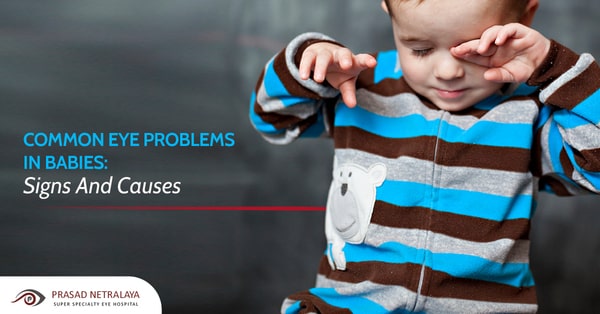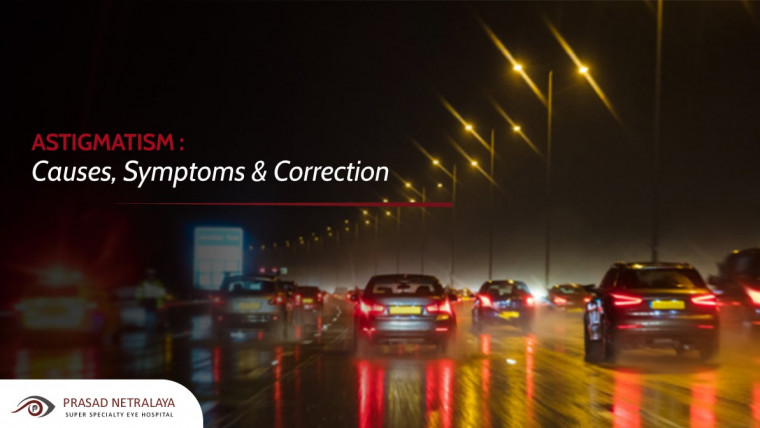When we think of eye problems, we often picture adults or children having them. But we need to consider that even babies can have vision and eye problems. Eye-related issues can develop in early childhood. If you are a parent, are going to have a baby, or have a baby in your family — it helps to be aware of baby eye problems so that you’re able to recognize signs and symptoms early on.
Table of Contents
Vision Development in Babies
In the first six months of life, a baby’s eyesight develops rapidly. This is how a baby’s vision develops —
- When a baby is born, their eyes are sensitive to bright light, and vision is not that sharp.
- They can focus on objects about 10 inches away from their face.
- Their eyes may not yet be well-coordinated in the first month.
- In about 5-6 months, a baby’s depth perception and colour vision improve gradually and significantly.
Symptoms of Baby Eye Problems
Here are some signs of vision problems in babies that you need to watch out for. If you see these symptoms, the baby’s eyes need to be examined:
- Excessive tearing: Babies produce some tears when they cry, and that’s normal. But if your baby experiences excessive tearing, even when you know they are not crying, it could be due to a blocked tear duct. The condition is called epiphora.
- Extreme sensitivity to light: Babies’ eyes are very sensitive to bright light when they are born, and oversensitivity to light is one of the common newborn baby eye problems. But if it is the same even after a month or two, it could be due to increased eye pressure.
- An eye turns inward or outward: A baby’s eyes may look crossed in the first month of birth. But if an eye continues to turn inward or outward beyond this period, it might be a problem.
- Visual coordination problem: As a baby’s eyesight develops gradually, their eyes must be able to track objects together after about 3 months. If their eyes can’t do so, there may be an underlying visual coordination problem
If you see these signs in your child, consider consulting a paediatric ophthalmologist.
Common Eye Problems in Babies
Now that you know some signs, you also need to be aware of some common eye problems in babies.
Amblyopia (Lazy Eye)
Amblyopia, also known as lazy eye, is when the vision in one of the eyes is reduced due to abnormal visual development. It occurs when one eye becomes weaker than the other during infancy or childhood. The weaker eye — often called the lazy eye — wanders inward or outward.
Refractive Errors – Myopia, Hyperopia, Astigmatism
A refractive error means that light entering the eye does not bend correctly, due to the eye’s shape. This causes the eye to not focus images properly on the retina, and what the baby sees appears blurry. It is mainly of 3 types:
- Myopia: Also called nearsightedness or shortsightedness, myopia is when one can see nearby objects clearly, but far away objects appear blurry.
- Hyperopia: Also called farsightedness, hyperopia is when distant and near objects appear blurry to the baby. The degree of farsightedness affects focusing ability — so the eyes may focus on faraway objects better than those nearby.
- Astigmatism: When the eye isn’t completely round, the light entering does not bend properly, resulting in blurred or wavy vision. This condition is called astigmatism and can occur along with nearsightedness or farsightedness.
Strabismus (Crossed Eyes)
When one eye turns inward, outward, upward, or downward — it causes misalignment of the eyes. This is called strabismus. It could lead to a lazy eye or sometimes even double vision in children.
Double Vision (Diplopia)
Double vision (diplopia) occurs due to the misalignment of the eyes (strabismus). The baby may see an object in two different places at the same time — in a horizontal, vertical, or diagonal fashion.
Genetic Eye Disease
Sometimes, babies may have diseases that are often inherited from family members. In cases of known hereditary eye diseases in the family, early evaluation is important.
Congenital stationary night blindness (CSNB)
This is a rare and often inherited, non-progressive retinal disorder that makes adapting to low light situations difficult due to impaired photoreceptor transmission. It could lead to reduced visual acuity and myopia.
Retinopathy of Prematurity (ROP)
Retinopathy of prematurity (ROP) is an eye disease that occurs in some premature infants. It is caused by abnormal development of the blood vessels in the retina. It starts mild but is known to be a progressive problem.
If you are concerned that your child may be suffering from any of the above pediatric eye problems, we recommend a consultation at Prasad Netralaya — Mangalore and Udupi‘s leading eye hospital with experienced ophthalmologists. Call us at +91 9513596565 or book an appointment if you wish to visit in person.



